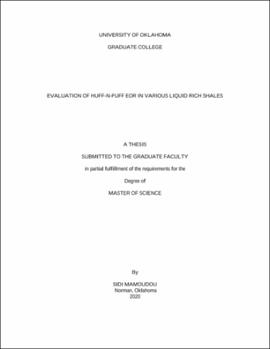| dc.description.abstract | Cyclical gas injection Enhanced Oil Recovery (EOR) known as “Huff-n-Puff” (HnP) has experienced renewed interest since the EOG success in the Eagle Ford shale play. HnP consists of injecting CO2 or a hydrocarbon solvent at a pressure above Minimum Miscibility Pressure (MMP) to maximize oil mobility. Re-pressurizing previously hydraulically fractured reservoir can yield an additional 30-70% more oil (Thomas et al., 2016). Traditional laboratory EOR studies usually focus on recovery evaluation on saturated plug samples and neglect microstructural alteration of the rock.
Our study consists of evaluation of cyclical gas injection performance on crushed samples with a rich mixture of methane and ethane (72:28mol%) on “preserved” or “as received” rock samples from; the Eagle Ford, Duvernay, Uinta basin, Montney and Meramec. A case by case evaluation of these formations is presented to capture the dynamic changes behind HnP by focusing on three major elements, the oil (viscosity and composition), the rock (porosity, pore throat size, pore body size, internal surface area and microstructural changes), and the solvent (MMP). This workflow integrates several petrophysical tools such as NMR, HAWK pyrolysis, MICP, BET, TOC, Helium Pycnometry SEM imaging to measure recovery and characterize rock-fluid interactions. A sensitivity analysis on NMR fluid recovery is performed to determine the major control parameters on EOR.
The results show that EOR HnP recovery is controlled mostly by the reservoir oil composition and pore throat size distribution. Rock properties such as mineralogy, TOC and total porosity are secondary controls on recovery. Pore throat size distribution is found to control production rate during EOR. The tighter the rock (pore throats size distribution <20nm) the more gradual the HC production. However, when the pore throats are large (>20nm) faster depletion is observed.
In addition, a newly define HAWK heaviness fraction, which is the ratio of the heavy components S14 to the total HAWK HC production can be used as a proxy to quickly screen cyclical gas candidates. Sample with HAWK heaviness fraction > 0.20% are found to be poor candidates for EOR using the rich gas.
Finally, SEM observations after EOR shows alteration of the organic matter but also alteration between organic and inorganic minerals. | en_US |
